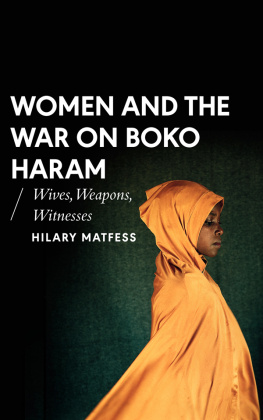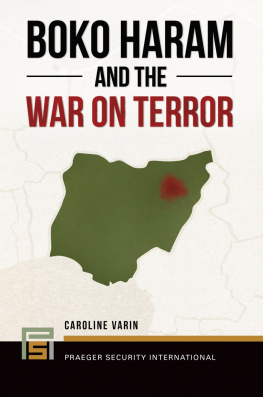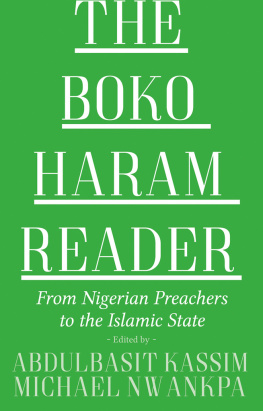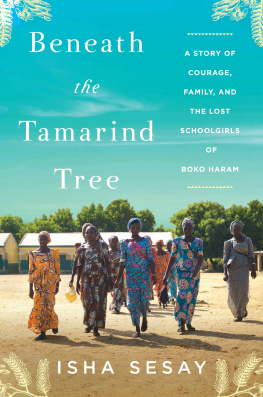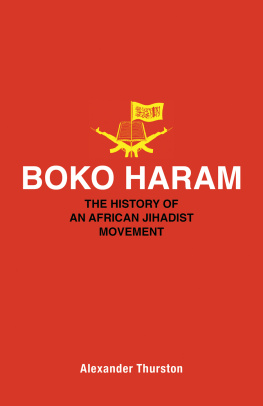Boko Haram
OHIO SHORT HISTORIES OF AFRICA
This series of Ohio Short Histories of Africa is meant for those who are looking for a brief but lively introduction to a wide range of topics in African history, politics, and biography, written by some of the leading experts in their fields.
Steve Biko
by Lindy Wilson
Spear of the Nation (Umkhonto weSizwe):
South Africas Liberation Army, 1960s1990s
by Janet Cherry
Epidemics: The Story of South Africas Five Most Lethal Human Diseases
by Howard Phillips
South Africas Struggle for Human Rights
by Saul Dubow
San Rock Art
by J.D. Lewis-Williams
Ingrid Jonker: Poet under Apartheid
by Louise Viljoen
The ANC Youth League
by Clive Glaser
Govan Mbeki
by Colin Bundy
The Idea of the ANC
by Anthony Butler
Emperor Haile Selassie
by Bereket Habte Selassie
Thomas Sankara: An African Revolutionary
by Ernest Harsch
Patrice Lumumba
by Georges Nzongola-Ntalaja
Short-changed? South Africa since Apartheid
by Colin Bundy
The ANC Womens League: Sex, Gender and Politics
by Shireen Hassim
The Soweto Uprising
by Noor Nieftagodien
Frantz Fanon: Toward a Revolutionary Humanism
by Christopher J. Lee
Ellen Johnson Sirleaf
by Pamela Scully
Ken Saro-Wiwa
by Roy Doron and Toyin Falola
South Sudan: A New History for a New Nation
by Douglas H. Johnson
Julius Nyerere
by Paul Bjerk
Thabo Mbeki
by Adekeye Adebajo
Robert Mugabe
by Sue Onslow and Martin Plaut
Albert Luthuli
by Robert Trent Vinson
Boko Haram
by Brandon Kendhammer and Carmen McCain
Boko Haram
Brandon Kendhammer and Carmen McCain
OHIO UNIVERSITY PRESS
ATHENS
Ohio University Press, Athens, Ohio 45701
ohioswallow.com
2018 by Ohio University Press
All rights reserved
To obtain permission to quote, reprint, or otherwise reproduce or distribute material from Ohio University Press publications, please contact our rights and permissions department at (740) 593-1154 or (740) 593-4536 (fax).
Printed in the United States of America
Ohio University Press books are printed on acid-free paper 
28 27 26 25 24 23 22 21 20 19 18 5 4 3 2 1
Library of Congress Cataloging-in-Publication Data
Names: Kendhammer, Brandon, author. | McCain, Carmen, author.
Title: Boko Haram / Brandon Kendhammer and Carmen McCain.
Other titles: Ohio short histories of Africa.
Description: Athens, Ohio : Ohio University Press, 2018. | Series: Ohio short histories of Africa | Includes bibliographical references and index.
Identifiers: LCCN 2018031924| ISBN 9780821423516 (pb : alk. paper) | ISBN 9780821446577 (pdf)
Subjects: LCSH: Boko Haram--History. | Terrorist organizations--Nigeria, Northern--History--21st century. | Terrorism--Prevention--Government policy--Nigeria. | Social conflict--Nigeria, Northern--Religious aspects. | Nigeria, Northern--Social conditions--21st century. | Nigeria--Politics and government--21st century.
Classification: LCC HV6433.N62 B6535 2018 | DDC 363.3250966909051--dc23
LC record available at https://lccn.loc.gov/2018031924
Contents
Illustrations
Figures
Maps
Acknowledgments
Thank you to Gill Berchowitz of Ohio University Press for her tireless support and encouragement of this project. We also thank the two anonymous reviewers for their feedback and suggestions. Over the years, we have both accumulated substantial debts in the form of support and encouragement, and we cannot thank everyone here. Nonetheless, we wish to especially acknowledge Cornell Universitys Institute for Africa Development, the University of Vermont Rakin Lecture series, and the Northwestern University Nollywood Working Group, who hosted presentations of this work in draft form. We are also grateful to Philip Ostien, who provided invaluable primary sources on Boko Harams early days, and to the communities of Kannywood filmmakers and Jos-based music video producers who were generous with their work responding to and influenced by the conflict. We dedicate this book to the lives of all of Boko Harams victims, and to the remarkable courage of so many Nigerians affected by its violence.

Map 1. Nigeria. Map by Brian Edward Balsley, GISP

Map 2. Northeastern Nigeria. Map by Brian Edward Balsley, GISP
Introduction
In July 2009, a showdown was brewing in Maiduguri, northeastern Nigerias largest city. On one side were the followers of a charismatic local Muslim scholar named Mohammed Yusuf. Yusuf had risen over the course of a decade from relative anonymity to become one of the most influential (and radical) clerics in the country, building a community of thousands of followers informally known around the region as Boko Haram (roughly, Westernization Is Forbidden). A powerful public speaker and skilled organizer, Yusuf taught that Nigerian Muslims had fallen away from the true Islam of the Prophets time and that it could only be restored by rejecting outside influences such as democracy and Western-style education. To that end, he and his supporters had amassed money, property, and (it was rumored) weapons in anticipation of a showdown with a government they regarded as entirely illegitimate.
On the other side were fearful local authorities, many of whom had watched Yusufs rise with interest and even sought to co-opt or collaborate with him on their own political schemes in the years following Nigerias surprising return to democratic rule in 1999. In recent months, they had responded to growing evidence of his strength and rumored connections to more violent movements in North Africa and the Middle East by stepping up their campaign of public harassment and intimidation, and the situation was clearly escalating. It would take only a little spark to set off an explosion.
On July 26, Yusufs supporters struck first, and the police and military responded with their full might. Within just a few days, eight hundred members of the group were dead, many reportedly killed in cold blood by security forces after the fighting had stopped. The tally included Yusuf himself, illegally executed behind a police station after interrogation. Soon after, the Nigerian government declared the movement over and the problem solved. Yet within a year, Boko Haram had rebuilt itself under the leadership of a charismatic and vicious figure named Abubakar Shekau, Yusufs former second-in-command. Under Shekau, Boko Haram fashioned itself into a violent jihadist movement dedicated to destroying the Nigerian state and establishing its own strident vision of Islam as the law of the land. Within just a few years, it would become one of the deadliest insurgencies in the world, capable of mounting well-planned bombings, brutal hit-and-run attacks and assassinations, and even winning pitched battles with the Nigerian Army.
Yet for the vast majority of Nigerians, the realities of the warand by 2013 it was indeed a war, with a federal state of emergency in three of Nigerias thirty-six states and a massive troop deploymentmade little impression. Nigerias political leadership downplayed the conflicts severity, both to its own people and the international community. Meanwhile, rumors (partially true but often wildly exaggerated) that the group was supported by foreigners circulated as proof that Boko Haram was not really a
Next page

